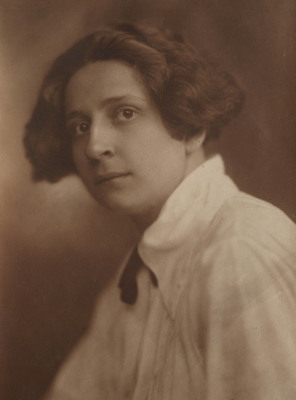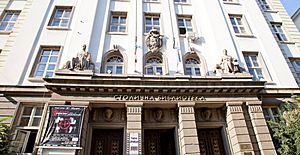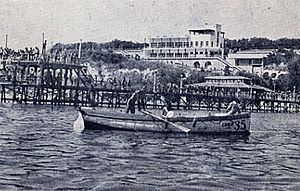Victoria Angelova facts for kids
Quick facts for kids
Victoria Angelova
|
|
|---|---|

Viktoria Vinarova, ca. 1920
|
|
| Born |
Bulgarian: Виктория Ангелова
20 November 1902 Veliko Tarnovo, Bulgaria
|
| Died | 27 December 1947 (aged 45) Sofia, Bulgaria
|
| Nationality | Bulgarian |
| Other names | Victoria Angelova Vinarov |
| Occupation | architect |
| Years active | 1926-1947 |
| Spouse(s) | Boris Vinarov (married in 1933) |
Victoria Angelova Vinarova (born Viktoria Angelova, Bulgarian: Виктория Ангелова-Винарова, 1902–1947) was one of the very first female architects in Bulgaria. She is famous for designing the first modern, national art gallery in the Balkans region.
Contents
Biography
Victoria Angelova was born on November 20, 1902, in Veliko Tarnovo, Bulgaria. Her father, Vasil Angelov, was a merchant who had studied in England. He named his daughter after Queen Victoria to honor her.
Victoria studied architecture at the Vienna University of Technology and the Dresden Polytechnic. She graduated in 1924. This was seven years after another pioneering female architect, Maria Luisa Doseva-Georgieva, got her license.
When she was 24, Victoria moved back to Sofia. She worked as an intern at the Ministry of Public Works. During this time, she won a competition for her first big project. In 1933, Victoria married Boris Vinarov, who was also an architect. They started their own architecture business in Sofia.
Victoria worked at a time when most public building projects were decided by national competitions. She designed buildings all over Bulgaria. However, she is best known for her work in Sofia. She received the Order of Civil Merit for her important contributions to the country's architecture.
In 1944, during World War II, Victoria and Boris's home was bombed. They lost many of their personal belongings, including their architectural drawings. They moved to Turnovo, where Victoria became very sick with pneumonia.
They thought she had recovered and returned to Sofia in 1946. Sadly, Victoria became ill again and passed away on December 27, 1947. Her husband, Boris, died just three months later.
Important Projects
Ministry of Public Buildings, Roads and Public Works
In 1926, the Ministry held a competition for a new office building. Victoria Angelova won the contest. However, she had to work with experienced architects like Georgi Ovcharov and Yordan Yordanov. They helped oversee her work.
The building covered a whole city block called "Slaveykov Square." It was bordered by "GS Rakovski," "William Gladstone," and "Han Krum" streets. Construction started in 1928 and finished four years later.
The building was designed in a Neoclassical style. This means it looked like ancient Greek and Roman buildings. It had tall marble columns and beautiful mosaic floor tiles.
Near the entrance were two statues. One was a female figure representing architecture, and the other was a male figure representing construction. There were also three stone heads above the doorways. These sculptures were made by Mikhail Ivanov, Stephen Peychev, and Cyril Shivarov.
The building had wide hallways and high ceilings. It also featured colorful stained glass windows. These windows were designed by Haralampy Tachev and made in Munich. Today, the building houses the Metropolitan Library and the "Renaissance Theater." It also has offices for doctors and dentists.
National Art Gallery
From 1934 to 1941, Victoria Angelova worked on the National Art Gallery. The building was finished in 1942.
The first floor displayed Renaissance paintings by artists like Stanislav Dospevski, Nikolai Pavlovich, Hristo Tsokev, and Zahari Zograf. It also showed handicrafts from famous folk art regions like Tryavna and Samokov.
The second floor focused on modern Bulgarian art. It featured painters and sculptors from the early 1900s. When it was completed, this building was known as the first modern, national art gallery in the Balkans.
Sadly, the gallery was bombed in 1944 during the war. It was completely destroyed. All the artworks inside were lost, including the full collection of works by sculptor Alexander Andreev Berhatliev.
Sea Casino of Burgas
In 1936, Atanas Sirekov, the mayor of Burgas, held a design competition. He wanted a casino built on Burgas Bay. Seventeen architects took part, and Victoria Angelova won with her design called "333."
The building needed a special design because the land was very steep. It also had to offer amazing views of the entire gulf. The casino was finished in 1938. Important people from all over the country attended its opening. They even got a 70% discount on train tickets to come!
The building was left empty in the late 1990s. After almost 20 years of not being used, it was fixed up and reopened in 2011. Now it is a cultural center. The renovation project won the “Building of the Year” award in 2011.
Raduntsi Lung Hospital
In 1937, a plan was approved to build a special hospital in the village of Raduntsi. This hospital was for people with lung diseases, like tuberculosis. It was called the Pulmonary Hospital.
It was planned to be the largest hospital of its kind in the Balkans. It was located 650 meters (about 2,130 feet) above sea level. Victoria Angelova won the contract to design and build this hospital.
Construction began in 1939, just before World War II started. By 1940, four stories were built. However, work had to stop until the war ended. Building resumed on September 9, 1944. But the hospital was not fully finished until 1955, nearly ten years after Victoria's death.
The first patients were admitted to the hospital on November 1, 1955. Due to money problems that started in 2013, the hospital had to close in 2015.
Other Selected Works
- 1926 Bulgarian Lawyers Association Building
- 1927-1936 Museum of Natural History, which was destroyed during the bombing of 1944 and rebuilt between 1947 and 1948.
- 1928-1932 Ministry of Public Buildings, Roads and Public Works, Sofia
- 1929 Provincial Office Building, Kardzhali, a project with Čavdar Mutafov
- 1930 Post Office in Burgas, her design won second prize
- 1930 General Directorate of State Railways, her design won fourth prize
- 1931 Military Club in Pleven, her design won third prize
- 1933 "Metropolitan Kliment" Girls 'School in Veliko Tarnovo
- 1934-1941 National Art Gallery, destroyed in the 1944 bombings
- 1935 Post Office in Plovdiv, her design won second prize
- 1936-1938 Sea Casino of Burgos
- 1937-1939 Girls' High School of Taksim, in Plovdiv, now the Academy of Music
- 1939-1955 The Raduntsi Lung Hospital
- "Father Paisii" Mathematics High School at #61 Iskar Street, Sofia
- "Vasil Drumev" Mathematics School in Veliko Tarnovo
Photo gallery





